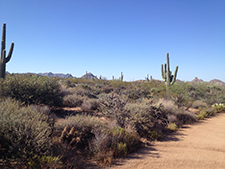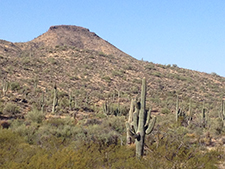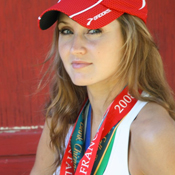Clint Eastwood, Moses, and Me
After all, it was three o'clock in the afternoon, and it was a desert. The black line on the thermometer rose menacingly and stopped at 111 degrees Fahrenheit.
But it was a dry heat.
I was so eager to embark on my first real desert run (“I can’t wait to explore the desert and run the desert mountains!” I had told everyone back home), I disregarded common sense and headed out for a run the moment we arrived at our hotel in Scottsdale, Arizona. I did so despite our hotel staff’s conscientious advice—given in the form of pamphlets not unlike those handed out by Doomsdayers standing on street corners outside baseball stadiums—not to venture out for “hiking or running in the afternoon due to an excessive heat advisory.” Instead, I grabbed a visor, some sunglasses, and my Amphipod bottle and turned left onto a black stretch of asphalt.
In retrospect, I really should have heeded the wisdom of the concierge.
I planned on running six miles, but the desert heat was enough to curtail such ambitions. The road was bleak and straight and, strangely, entirely uphill. I ran a quick but human out-and-back for a total of three miles (and change). At one point, tumbleweed whooshed by in a brilliant manifestation of cliché. I realized I was going to die in the desert.
Miraculously, I didn’t, and I set my alarm for 5:30 the next morning. I wanted to be running by 6:00 a.m. The desert is nice at 6:00 a.m. Nobody dies in the desert at 6:00 a.m.
Dutifully, thanks to Steve Jobs, my iPhone blared a melodious and tinny harp at 5:30 on the dot. I don’t remember what happened next. All I know is that when I climbed out of bed, it was 6:37 a.m.
Rats! I wanted to be on the trail running by this time. The high that day was predicted to be a balmy 112 degrees Fahrenheit.
But it’s a dry heat.
In a flustered rush exacerbated by a dark hotel room (I didn’t want to wake my sister), I dressed and grabbed my trusty Amphipod bottle—the twenty ounces separating me from certain death—and forgot my Garmin, as well as my hotel key, which meant that everything I had forgotten in my hotel room would remain in my hotel room.
My explorations that day would take me to Brown’s Ranch Reserve, a sprawling desert conservation area a quick two-mile jaunt (uphill) from our hotel.
Brown’s Ranch is glorious in a beautiful, parched, barren, dry, forsaken, reeking-of-death kind of way. Miles upon miles of desert stretch across an undulating landscape girdled by distant, jagged mountains. The main trails are neatly marked and measured. The offshoots—the ones that lead heaven knows where—are not. Each of these tantalizingly perilous routes is identified by a giant wooden sight:  “CAUTION: You are now entering unmapped territories. Proceed at own risk.”
“CAUTION: You are now entering unmapped territories. Proceed at own risk.”
With these trails, I was unconcerned. I would not be venturing into unmapped territories. There was one sign, however, that caused great amusement at best and bed-wetting terror at worst. This sign was located at the Brown’s Ranch Road Trailhead, a delta from which all trails, mapped and unmapped, sprang.
On a wall very near the wall with the trail maps was a small sign that gleefully warned visitors to “respect” the mountain lions, rattlesnakes, coyotes, and scorpions that called the reserve their home. This was not the sign that bothered me. Nestled between the two helpful walls was an ominous and terrifying notice four times as big as the sign with the rattlesnakes and mountain lions on it:
WARNING: THERE ARE BEES ON THIS RESERVE. BEWARE OF BEES!
What? Bees? What do you mean bees? Like, they come out of nowhere and attack you? How bad are the bees that they get top billing over rattlesnakes and mountain lions?
Honestly, I didn’t even know the desert had bees. Bees don’t strike me as particularly desert-y. But, as it turned out, there was a lot about the desert I didn’t know.
This is kind of how I pictured the outback in Australia… I mused as I ran. Only here, everything isn’t trying to kill you.
But, as it turns out, some things are.
When I went to Australia, I didn’t have to research all the ways I could be eaten alive by the flora and fauna. My friends took care of that. (Thanks, horrifying Buzzfeed lists!) But here, in Arizona, I quickly realized I knew nothing about indigenous dangers, other than that you should avoid running into cactuses. I kept getting my “bleak and barren” landscapes mixed up.
Red fire ants… They eat people. Are there red fire ants in Arizona? Or is that only Africa?
Dingoes… Definitely Australia. But is there an American version of the dingo…?
And then I spotted eight large and portly mammals crossing the trail in front of me.
What in the…? They looked like wild boars. They were ghastly.
I was far enough back that the wild boars were able to cross the road before I reached them. They scurried into the brush, much to the apparent relief of two hikers whose way had been momentarily obstructed.
“What was that…?” I asked them. They looked like locals. Or at least experienced.
“Hamarita,” said the woman.
Hamarita? Ha! I thought. It sounded like another flavor in the Bud Light beer margarita family, like “Lime-a-rita” and “Straw-ber-rita” and “Ham-a-rita,” which, presumably, tastes like ham.
In reality, she had said, “Javelina.”
Javelina, as I would have known had I spent any time at all researching the terrain I was so eager to explore, are basically wild boars. They are vegetarian, but they eat trash and can be quite mean. As Google later informed me, “defensive javelina behavior may include charging, teeth clacking, or a barking, growling sound.”
Not long after my encounter with the javelina, I ran into a trio of donkeys. As I ran closer, I discovered they were deer. Closer still, and they were donkeys again. I slowed down to stare at them. They stared at me. I stopped.
Enter music from The Good, The Bad, and the Ugly.
I left the donkey deer to graze among the prickly pears and ran further and further and further into the desert. (Note: I later learned that the donkey deer are actually called “mule deer.” Upon learning this fact, I felt quite pleased with the name I had given them on my excursion.)
Maybe it’s just me, but there is something about running in the desert that makes me acutely aware of death. Namely, 50 percent of my thoughts when running through the desert are, “I’m going to die.”
I don’t know why this is. Perhaps it’s because the desert is so foreign to me. Perhaps it’s because I know my own cavalier runner’s attitude (“I’ve run farther on hotter days than this!”).  Perhaps I’ve seen too many movies where people die in the desert. (Seriously. What else do people do in the desert?) But whatever the reason, running in the desert and death are inextricably related.
Perhaps I’ve seen too many movies where people die in the desert. (Seriously. What else do people do in the desert?) But whatever the reason, running in the desert and death are inextricably related.
I began, involuntarily, to bequeath my possessions to my siblings.
Alicia can have my Garmin. Emily can have my Nike running hat.
I passed a giant anthill writhing with the ebb and flow of ants.
They will eat my flesh when I die here. I will be nothing but bones after they are through with me.
I was thirsty. Even the cactuses (cacti?) looked like they were begging for mercy from the heat and the sun.
And then the temperature got real.
Desert mornings are deceiving. They aren’t heavy and humid like they are in St. Louis. They are crisp and clean and (dare I say it?) cool. They tantalize runners with coolness.
Come run! they beckon. Look how much better we are than the afternoons! Can you even remember the heat of the afternoon? No, you cannot. What heat? What desert?
Remember, the high for the day was 112.
This is how the temperature rises in the desert. It is not a gradual, cumulative climb. It is a shotgun start. The heat waits patiently behind a seductive, restrained, transient climate and then boom! It is an all-out sprint to 112.
The race began around mile seven.
I didn’t know the exact distance I had run or the exact distance I had left, but mile markers along the trail gave me some idea. I was running low on water. My mind wandered from making my will ("Joe can have my Blues hat") to Clint Eastwood to the Exodus of the Israelites and their subsequent wandering the desert for forty years. It was all very Western or Biblical and sometimes both. In the throes of my thirst, Butch Cassidy and the Sundance Kid were chatting it up with Moses.
“Are you Mary?”
I was jolted from my reverie by a man who very well may have been the national mascot for the Boy Scouts.
“I’m sorry?”
“Are you Mary?”
From his appearance, I expected him to say, “Dr. Livingstone, I presume?” Mary threw me for a loop. But then I couldn’t stop wondering about her—at least in that split second.
Why are you asking if I’m Mary? What happened to Mary? Is she lost? Are you lost? Did you get lost looking for her?
“No, I’m sorry.”
“Oh, I thought you might be Mary. There’s a woman who runs here all the time. From a distance you looked like her.”
“Oh…”
Eleven miles later, I made it back to my hotel. I had not died in the desert. In fact, the run was glorious, even though I had spent a good portion of it envisioning the end of my existence. Running in the desert is exhilarating exactly because I spend half the time feeling like this and the other half feeling utterly inferior to the elements.
You just have to watch out for all those BEES.

Amy L. Marxkors is the author of The Lola Papers: Marathons, Misadventures, and How I Became a Serious Runner and Powered By Hope: The Teri Griege Story. Click here to receive Amy's weekly article via email.
Connect With Us
see the latest from Fleet Feet St. Louis